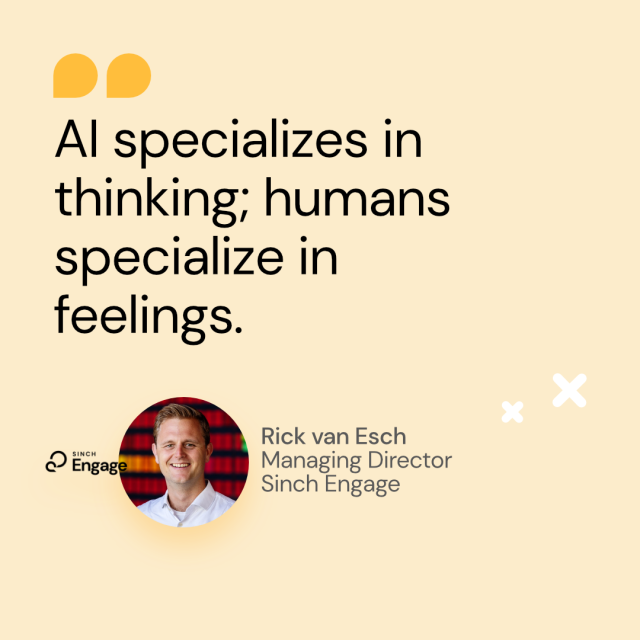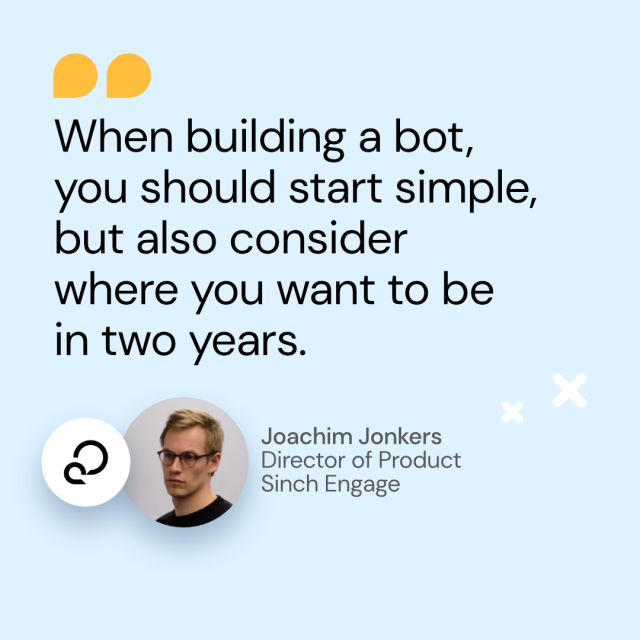What are the biggest trends in conversational AI right now, and how can businesses benefit? We take a look at the top five AI trends for 2023, and share insights from experts!
From Apple's new VR glasses to ChatGPT: AI is clearly having a moment in 2023. In the following, we take a look at the five biggest AI trends of the year, and what they mean for businesses.
1. GPT is here to stay
From GPT-4 to ChatGPT, the smart bot technology from OpenAI is probably the biggest AI trend of the year!
The conversational AI solution has brought chatbots to the masses, and changed how people feel about AI. People went from being very skeptical to asking ChatGPT about everything! And: GPT has also made its way into business solutions, such as combining GPT with messaging apps.
However, there are still some shortcomings. For example, as of now, it's not possible to fully control the output of the open GPT models, which might be funny in a private setting, but a risk for companies. It's also difficult to work with external knowledge that it doesn't have, which makes the technology hard to scale.
Still, in combination with conversational AI there could be some interesting developments in the future, says Fréderic Godin, Head of AI at Sinch Engage & Chatlayer. Check out his tips into how businesses can actually leverage the hype!
2. AI will make us more human
Even though AI has become more integrated in our daily lives, there are still a lot of prejudices around technology. They range from: “chatbots are really stupid” to: “AI is conscientious, and already replacing humans”. The reality is far less extreme!
While it’s understandable that there are fears around AI chatbots (as there are around any new technology), bots are not here to replace humans. In fact, they can actually help us become more human, says Rick van Esch, VP SaaS Business at Sinch. Because bots and people have different strengths, the technology doesn’t work against humans, but is here to support us, and to help us re-focus on what makes us human: feeling.

3. Chatbots are becoming a standard business solution
Another important AI trend for 2023 is that chatbots are becoming a standard solution for businesses of all sizes. As the technology has matured, it's become more accessible to smaller businesses and more accepted (and wanted!) by customers.
Of course, this comes with its own set of challenges. So, businesses need to have a clear road map, find reliable partners, and start building their expertise now in order to keep up with competitors. Joachim Jonkers, CPO at Chatlayer by Sinch, explained at this year's Chatbot & Voice Summit how businesses can take on these challenges and turn them into successful solutions.

🤖 Also check out our Conversational Everything Masterclass where we talk with Joachim Jonkers about chatbot trends!
4. Messaging and Conversational AI are becoming the new dream team
Messenger services, from SMS to WhatsApp, are inherently conversational. This makes them the perfect platform for combining conversational AI and messaging. And companies are realizing that! From mobility to health to e-commerce, more companies in different industries have started implementing and benefiting from chatbots.
The Dutch e-bike company VanMoof, for example, uses an omnichannel chatbot named “Boost” to manage an increasing number of customer queries. With the help of the bot, VanMoof has been able to personalize the customer experience, provide help in multiple languages, and reduce the workload for their employees. The bot can, in fact, handle 70% of customer queries.
The Dutch e-commerce giant Bol.com has made a similar experience with their chatbot, Billie. Billie offers Bol.com customers a 24/7 service, faster help, and frees up time for service agents, says Yanick von Altena, Product Owner Billie Chatbot Team at Bol.com.
In addition, Billie can also gather valuable customer data in a central place, which has served as an early warning detector for Bol.com in the past.
Similarly, Arnoldo Gonzalez Medina, Digital Project Manager at Calzzapato, recognizes the value of combining conversational technologies with messaging. The Mexican shoe brand started offering messenger apps like the Messenger from Meta or WhatsApp as customer service and also uses them as marketing channels.
The customers responded very positively, as they were able to contact the company on their favorite messaging apps. For the company, the use of conversational channels like WhatsApp also helps them to learn more about their customers’ needs and preferences.

5. Marketing is becoming more conversational
Chatbots have been a great help for customer care departments, but companies are starting to see the additional value of conversational technology on every stage of the customer journey.
Matt Ramerman, President at Sinch for Marketing, explains that especially when it comes to lead generation, conversational marketing can unlock a lot of untapped potential: by engaging customers in two-way-conversations.
Instead of trying to get users to click on a specific link or by a certain product, companies should give them the option to reach out and ask questions about services they are really interested in. This will lead to more engaged customers, but also to higher conversions, says Ramerman.

AI trends 2023: The future will be conversational
From GPT-3 to conversational messaging to AI chatbots in enterprises: it's pretty clear that AI is heading into its next stage. It's more interactive, more user-centric, and easier to integrate with other technologies.
Overall, in 2023 AI is going conversational!





